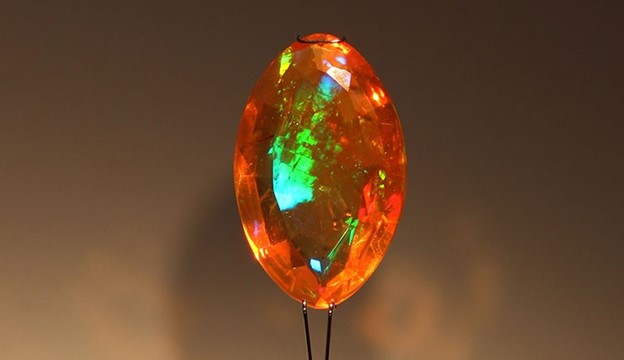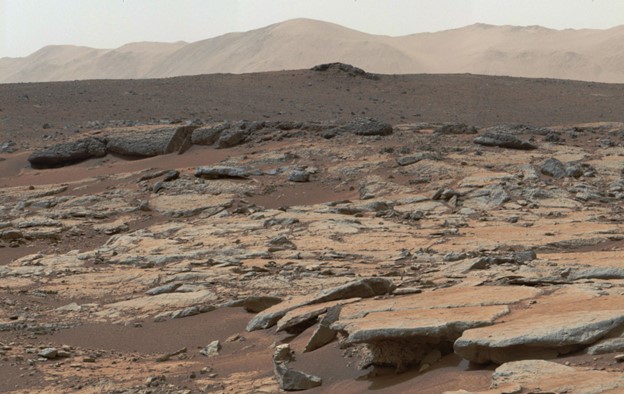by Rida Fatima

(Figure 1: Discovery of Opal on Mars is significant evidence of Water in the past over the Martian surface)
A type of opal found in a Martian meteorite that can trap bacteria on Earth has been identified as a new target in the quest for indications of life on Mars.
A team of Arizona State University and NASA-affiliated researchers released a study last month in the Journal of Geophysical Research: Planets. According to the study, NASA’s Mars Curiosity rover has recently discovered a water-rich mineral, Opal. It was revealed in the fractured halos of the gale crater located on the red planet. Curiosity completed its ten-year Mars exploration mission in August 2022. The core objective was to search for evidence of primitive life on this planet. As the largest and most capable rover ever sent to Mars, curiosity is NASA’s Mars Science Laboratory mission. NASA’s spacecraft has previously detected Martian opals from afar, and they have been found in Martian meteorites that were once fallen on Earth. Recently, a team led by Travis Gabriel, a research scientist at the US Geological Survey, has discovered light-coloured opal deposits on the Martian surface (Rayne, 2023).
Mars is a dry and desolate land that is constantly blasted with harmful solar radiation which is why the planet’s surface is inhospitable to life as we know it. Although, the darker environment inside the subsurface is adequately sheltered from the deadly radiation bombarding Gale Carter on Mars. Hence, the presence of water-rich opals within these fractures adds to the excitement of their discovery. (Bresson, 2023)
Curiosity Data From Mars
Water ice on Mars is prevalent at the poles and yet scarce at the equator, more specifically at the site of the Gale crater. Curiosity rover previously transmitted data from its DAN (Dynamic Albedo of Neutrons) spectrometer. It was then analyzed by a team of researchers who recognized cracked or fractured halos, rings of light-coloured sediment that appeared out because of their colour in both older and more recent Curiosity images. Further tests demonstrated that the light-coloured rock on the Martian surface was undoubtedly opal. Opals, which are considered gemstones, have sparkling colors that resemble rainbows. When silicon oxides dissolve in a damp atmosphere, they solidify in the gaps between rocks, forming these gems. This method converts opals into a small oasis that can hold up to 20% water.

(Figure 2: Gale Crater on Mars Credits: NASA/JPL)
Source Of Water On Mars
Scientists are hoping these Martian rocks comprising opal might be the source of water on Mars. As the composition of opal is mostly water and silica, the existence of this mineral could indicate that water once was present in these cracks to make them habitable. Moreover, opal on the Martian surface may one day be obtained for the water stored within, providing a source of water for future manned space missions on Mars. On Earth, opal can be found at the bottom of oceans, in geysers and hot springs or other water bodies. When silica particles settle to the bottom, they begin to form opal. Water can be extracted from opals because, even though they sparkle, they are still not minerals.
“Given the vast fracture networks identified in Gale Crater, it’s fair to predict that these potentially habitable subsurface conditions extended to many other portions of Gale Crater, and maybe to other regions of Mars,” Travis Gabriel said. He added “These ecosystems would have arisen long after Gale Crater’s old lakes dried up.”
The minerals constitute a firmly bound crystalline structure, whereas opals have a more loosely organized structure, that allows water to be removed. In case additional opal is located, astronauts exploring Mars in the future may have a large water source to extract water from. According to the statement, the fracture halos 1 metre in diameter “might store around one to 1.5 litres of water in the topmost foot of the surface.
Conclusion
The discovery of opal in the Gale Crater of Mars has given the Perseverance rover a new direction. If opal fracture halos exist on this crater, then they may also occur at Jezero Crater, where NASA’s Perseverance rover is looking for clues of past life. As Jezero Cater was originally a lake, there is a high probability that there could be more Martian opal waiting to be discovered. The existence of opal minerals in Martian Gale Crater shows that the planet may also have suffered short-term floods in the ancient past. Although it seems doubtful that life today exists on the arid surface of the red planet, these transient floods may have helped the microorganisms (bacteria or viruses) survive deeper down, or preserved microbial traces in opals. Gabriel is excited to investigate silica-rich structures at a new region on Mars to better comprehend the dynamics of water-rich environments on the red planet.
Bibliography
- Bresson, D. (2023, January 07). NASA’s Curiosity Rover Discovers Opal-Gemstone On Mars . Retrieved from forbes: https://www.forbes.com/sites/davidbressan/2023/01/07/nasa-rover-discovers-gemstone-on-mars/?sh=59e1dfaa2335
- Rayne, E. (2023, January 11). Curiosity rover discovers opal gems on Mars with clues to watery past . Retrieved from Space.com: https://www.space.com/mars-opals-water-habitable
